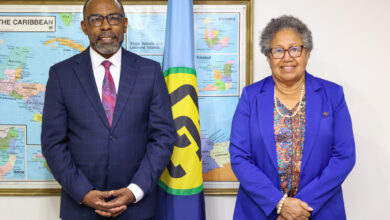We are meeting here because the negotiation of the EPA is at a crucial point. We still have to reach an agreement on some key points, not least the market access arrangements that need to be WTO compatible. Peter has spoken on these issues.
Obviously, we also have to address the question of development finance. I believe we share the understanding on one point: the EPA is an instrument that can liberate the potential that trade can bring to the development of the region by creating a regional market, by liberalising movement of goods and services, by improving productivity and competitiveness, and by establishing clear rules that permit the smooth functioning of this integrated market. This is the ultimate objective. This however requires significant efforts on your side, efforts of adaptation and restructuring, in the short term, in the medium and the long term. We are prepared to offer assistance and partner you in this endeavour. We are on your side.
Today, I would like to take stock of what we have achieved together this last year. We have come an impressively long way, and we can rightfully be satisfied of what is being done. We have done everything to prove that we take our commitments very seriously in the effort to make the EPA a real trade AND development partnership.
So where de we stand?
Firstly, you want an agreement promoting sustainable development. We have agreed to include in the text of the EPA a chapter entitled “Partnership for Trade and Sustainable development“. Furthermore, each trade chapter identifies, in very clear terms, the potential areas of development cooperation required. Finally we have taken jointly mutual commitments on social issues, the environment and food security. This is an innovative approach, a unique model that symbolises the attention given by both our regions to sustainable development and the reduction of poverty.
Secondly, you want substantial means to accompany the EPA process. These are available. And they are available rapidly. The range of Community instruments available is impressive.
- Under the 9th EDF, €76 million of the Regional Cooperation envelope are allocated to supporting regional Integration and the establishment of the CSME – Caribbean Single Market and Economy – the preparation of the EPA, and the development of the Private Sector. Most of these activities have started.
- To this, one must add the substantial support for the traditional sensitive products of the region. In total, €680 million. The Special Framework for Assistance to Banana Growers (SFA) – by 2008 we will have committed €230 million for the restructuring of the banana industry (1999-2008). We have supported the adjustment of the Rum sector to the tune of €70 million. The rice sector has received € 24 million. The sugar sector will receive a total of €350 million for the period 2007-2010, and this assistance will be extended during the period 2010-2013.
- Together, we are making an even bigger effort under the 10th EDF.
- Let us start with the Regional Programme. In comparison with the 9th EDF, we have gone from an allocation of €57 million to €132 million. That is more than double the 9th EDF allocation. I have recently also taken the decision to increase this allocation by 25% specifically for funding activities related to the implementation of the EPA. This makes a total of € 165 million. This is recognition of the region’s efforts, of its ambitions and of its needs. The Caribbean is the first region to benefit from this decision to allocate additional resources to address the needs related to the EPA.
- Let us now look at the National Programmes. I am really happy to see that almost all the National Indicative Programmes include activities linked to the EPA. More specifically, I note that five countries have identified Competitiveness as the focal sector of their NIP. Three countries have chosen Governance, and three countries have chosen Infrastructure. In total, 12 out of 15 are using the opportunity offered by the 10th EDF National Programmes to prepare for the challenges of tomorrow. This represents a total of € 454 million. This is really great, as we are talking of 75% of the total national allocations of € 600 million.
Thirdly, you are looking for funding additional to the EDF.
- It is certain that there will be funding coming from the Member States of the EU. The October 2007 Council will take the firm commitment to allocate around 50% of the increased funds allocated to trade-related to the ACP states. Recalling that the Member States have committed themselves to reach € 1 billion per year by 2010, this increase represents a very substantial amount. And it is clearly new money. I fully understand your concern regarding how much of this allocation will come to the Caribbean. Before coming to Montego Bay, I made contact with the Ministers of several Member States to ask them about their intentions regarding the funding of the Caribbean EPA process. They have confirmed to me that they fully share my thinking that Europe needs to ensure that all the ACP regions benefit equitably from this additional aid and that they would contribute.
- Other institutions of the European Union will also support the EPA process. I am in contact with Mr Maystadt, the President of the European Investment Bank, and discussed with him the continuation and reinforcement of the EIB’s activities in the region.
Fourth, you have drawn our attention to the need to ensure the greatest possible efficiency in the delivery of our aid. This is a subject to which I am highly sensitive. I believe I have responded to your concerns in various ways.
- On the one hand, as I had announced some time ago, I have insisted on the significant increase of the use of Budget Support as a delivery mechanism. In 11 countries out of 15 in the Caribbean Region we are doing Budget Support. This represents a total of € 340 million, or 57% of the national allocations. Taking into account the Regional Programme, this figure goes up to over 60%.
- On the other hand, as I have already said on many occasions: I am convinced that a structure such as a regional development fund has a lot of merit as a channel of funding: rapidity, additionality (through the support of other donors) ownership of the region on the best use of the funds, flexibility etc.
Finally, we have to work at the best possible coherence between the programmes selected and the identified needs.
- Right now, we should give priority to the finalisation of the programming exercise of the Regional Programme of the 10th EDF, for which discussions are still ongoing. As I mentioned earlier, there is around € 165 million (or more than 230 million US Dollars) available for this programming. It is crucially important to use this programming exercise to address the real needs linked to drawing the best possible benefits from the opportunities that emanate from the EPA.
- In this sense, I very much welcome the meeting on 10th EDF Programming that is to take place in Haiti in two weeks time. We are open to all proposals that go towards supporting the reforms that may be required. Consequently, we are of course also open to the idea of including the question of the fiscal impact of the EPA. With a view to neutralising the net fiscal impact, we would reinforce the Budget Support option and include a chapter on the fiscal aspects in the EPA text.
- Obviously, there is also the ongoing work of the RPTF (Regional Preparatory Task Force), which involves translating the cooperation articles in the EPA into specific programmes, including estimating the related costs, of which a part is to be funded from the regional programme.
- Let me reiterate what I have already said: that the EPA will enter into force gradually, so, it is up to the Caribbean region to arrive at a consensus on the priorities and particularly on the use of the regional funds available. Massive assistance will be made available, but it is also crucial that we plan together the optimal use of these resources to best address the identified challenges and in accordance with the real priorities.
One final point I would like to make on resources: EPAs are a long term challenge, with transition periods running up to 25 years in some cases. All the necessary reforms and other changes are not for tomorrow morning. It is necessary also to recall that the full implementation of the EPA will not happen from one day to the other on January 1st 2008. The EPAs are long term processes and as we all know the transition periods being negotiated are also long. This also means that all the accompanying measures will not necessarily apply in 2008. This is good in more ways than one, because in fact it is doubtful that the absorptive capacity of the region could cope. Therefore the needs will have to be programmed over a number of years and will also cover other resources such as the 11th EDF.
In total, if I were to summarise the funds immediately available from the 10th EDF and the Sugar Accompanying Measures, and then extrapolate these amounts over the period 2013-2020 under an 11th EDF, I would arrive at a total of more than € 2 BILLION over 20 years. You would agree with me that this is a very significant amount.




